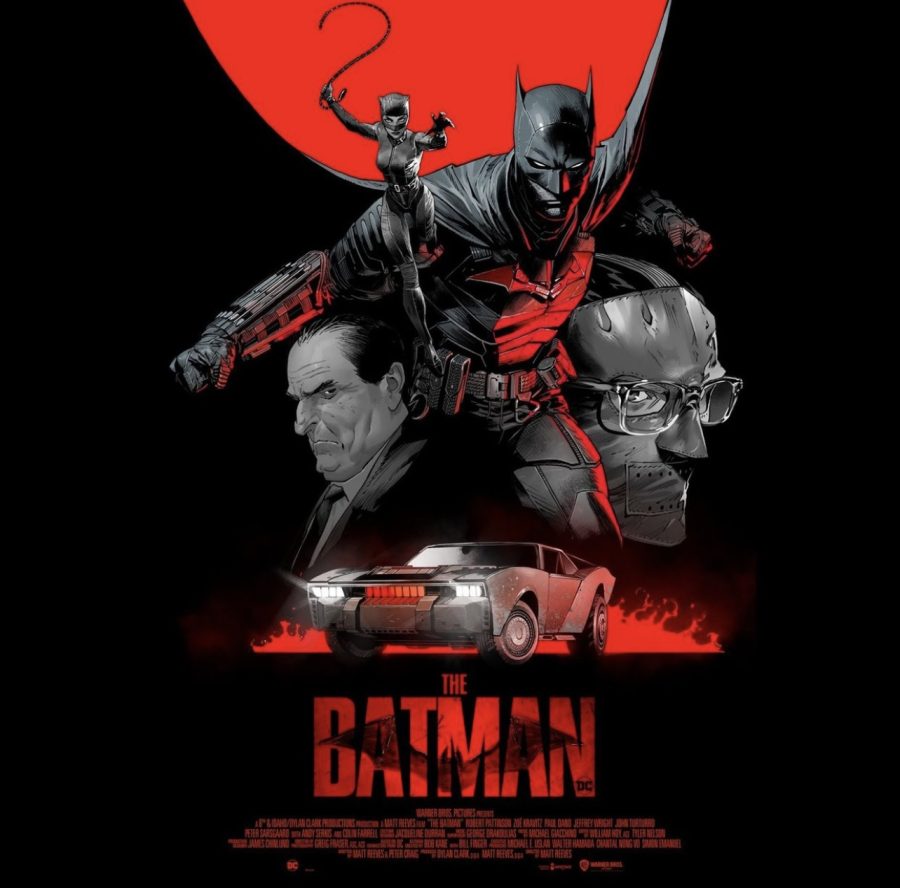The Batman is vengeance in Matt Reeves’s latest installment
March 28, 2022
Diving deep into the mind of 30-year-old Bruce Wayne’s early days as the masked vigilante, “The Batman” is a three-hour roller-coaster ride through the protagonist’s dark-twisted nightmare. Truly a sight for sore eyes, director Matt Reeves and producer Dylan Clark have painted a rainy and dreary Gotham City in bloody red; high off crime and riddled with corruption, atrocity and malice.
Much like Tom Holland’s “Spider-Man” movies, the film skipped on the played-out origins showcasing the death of Bruce Wayne’s parents and jumps right into the early stages of Batman’s career. Reeves and Clark commit to a detective noir approach to depict arguably one of the most comic book accurate versions of Batman ever seen on the big screen. “The Batman” succeeds in creating its own origin story by not following in the footsteps of its predecessors and displays the most unique on-screen portrayal of the caped crusader.
Bruce Wayne’s alter-ego, Batman, played by Hollywood heartthrob Robert Pattinson, is an unsanctioned, mastermind detective working with the Gotham City Police Department (GCPD) to solve a string of murder mysteries of key political figures committed by Batman’s arch-nemesis the Riddler, played by Paul Dano, whose character first appeared in Bill Finger’s “Detective Comics” (DC) #140 in Oct. 1948.
A culmination of select scenes subtly nods to “Rogue One: A Star Wars Story,” “Se7en,” “1984” and “Halloween,” among others, to create the black and ominous ambiance leaving audience members questioning their own mental sanity as they try to decode the Riddler’s puzzles with Batman.
The film in its entirety is a perpetuating cycle of riddles left at the scene of malevolent murders in the form of letters written “To ‘The Batman,’” rewarding the protagonist with hints to the next crime scene. In reality, the Riddler uses Batman to bring Gotham’s most corrupt political figures into the light, which helps introduce the detective side of Batman, something the other live-action films have failed to do.
Pattinson’s version of Batman is probably the most unconventional interpretation of the Dark Knight. In the other live-action adaptations, Wayne uses his public persona as a façade to shield his identity as Batman. Wayne, the playboy billionaire chairman of Wayne Enterprises, dispenses money and influence to make Gotham City a better place, while his double-life persona, Batman, is a masked vigilante utilizing fear tactics and combat to fight crime.
Typically, Wayne and Batman are not characterized as counter-opposites, but “The Batman” is far from conventional. Erratically, Pattinson’s Wayne and his version of Batman share commonalities as Wayne’s grunge aesthetic remains brooding and silent throughout most of the film, carrying over to the vigilante’s persona.
Building upon the maverick duality of Batman and Wayne, viewers witness a different version of Wayne as Pattinson does not render the playboy attitude seen in previous character archetypes, such as Michael Douglas in Tim Burton’s series, or Christian Bale in Christopher Nolan’s trilogy.
And unlike the Wayne that D.C. fans are normally acquainted with, Pattinson’s Wayne avoids public appearances and is somewhat nocturnal, as he fully allocates his dedication into living as Batman instead of balancing the responsibilities between hero and billionaire philanthropist. This may be because it is still early in Batman’s career, and Wayne may not know how to normalize his double-life. Regardless, it will be interesting to see in future Pattinson films if Wayne develops into a more familiar version of the Wayne archetype.
Following suit to the 1940s comics, Reeves and Clark have outdone themselves by spotlighting the Riddler as an obscene menace who subsides his obsessive-compulsive tendencies through toe-curling riddles and committing crimes against humanity. However, ditching the Riddler’s original character description, the audience witnesses the mental insanity seen in Batman’s most notorious villain, the Joker.
For context, Jim Carrey’s Riddler in “Batman Forever” was colorful and cartoonish to align with younger audiences’ partiality. Meanwhile, Dano’s Riddler is more reminiscent of the Zodiac Killer, the unidentified serial killer who haunted the streets of Northern California in the late 1960s, or even the murderous Michael Myers in “Halloween.” In fact, costume designers Glyn Dillon and David Crossman strategically drew inspiration from sketches and descriptions of the Zodiac Killer to emulate a sadistic murder, perfect for Dano’s Riddler.
The Riddler is not the only active antagonist. Another classic villain, The Penguin, played by Colin Farrell, makes moves on and off-screen, contributing to the plot development and giving the impression that Gotham is vastly more corrupt than initially perceived.
Let’s not forget about the dynamic duo between “The Bat” and “The Cat,” or Catwoman, played by Zoë Kravitz, whose love story promptly builds yet slowly unravels as the film prolongs. Kravitz’s character’s continuity with DC Comics and prior franchise installments is exceptional; Kravitz uses her innate sex appeal, seduction and flirtation to channel Catwoman, uncovering answers regarding her own self-interest. Thievery is no foreign concept to Catwoman, as she uses this skill set to assist her winged counterpart.
Another heartwarming relationship in a rather discomforting film is Batman’s association with one of Gotham’s finest and the only believer in Batman’s abilities in the GCPD, Lieutenant James Gordon, played by Jeffrey Wright. Lt. Gordon welcomes Batman’s insight and crime-solving prowess, the same of which could not be said for the rest of GCPD. Their partnership resembles that of the classic good-cop/bad-cop dynamic, working in synchrony to permeate Gotham’s way through the Riddler’s foreboding crimes.
Rather than cinematically delineating a sequence of events, Reeves’s and Clark’s decision to incorporate conversations between a multitude of characters to describe prior events to rationalize a character’s actions makes the plot development fall short at times. While some may argue Pattinson’s mannerisms tenuously reveal he is uncomfortable in his new role, as the actor has some big shoes to fill portraying one of America’s favorite superheroes. Wayne’s emotional distress and dreary sadness is awkward, especially in comparison to the character’s earliest depictions.
However, even with unorthodox character delineations, the film consistently has audience members clenching the edge of their seats, engaged in the protagonist’s heroism matched with the high intensity of the main antagonist’s vulgarity and clever discernment. Fans will have to hold on tight, relish in the adrenaline and exemplify undeviating patience for “The Batman’s” sequel, predicted to hit theaters sometime before 2027.












